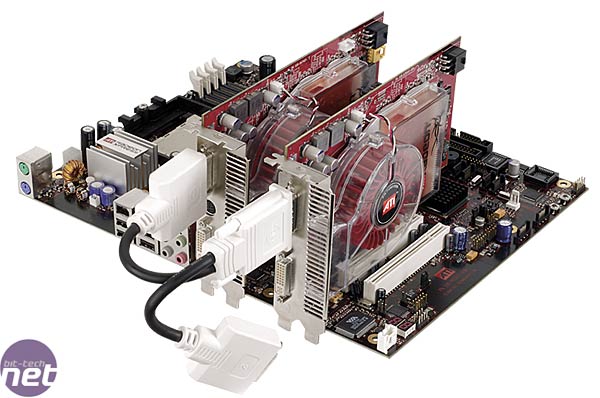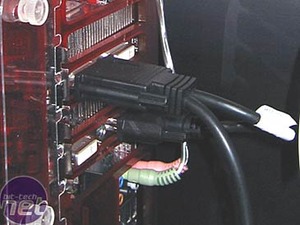Over the past couple of weeks, we have been focusing our efforts on bringing you a thorough upgrade guide for NVIDIA’s SLI solution. We continue the dual-GPU theme today with the announcement of ATI’s CrossFire – the Canadian graphics giants answer to NVIDIA’s improving SLI technology. It’s a technology that has been known as MVP, Multi-Rendering and many other different names. This week, one thing is certain – MVP has a name.
It’s a technology that has many differences and many similarities to NVIDIA’s SLI. Today, we're covering the basics behind the technology, and have a quick overview of the much-discussed Master video card. Despite what we had reported earlier, we can confirm that ATI’s CrossFire Edition video cards are not huge – they’re simply the same size as any typical ATI video card.

NVIDIA perform these calculations inside the GPU, but by employing an external solution, ATI eliminate that overhead, thus theoretically freeing up extra GPU resources to focus purely on rendering. However, by the very nature of using an off-die chip, there will be a degree of latency introduced - each side claims to employ the superior technique while criticising the other method. We feel that the pros and cons of both solutions cancel each other out, and since it is all a very small scale anyway, it isn't worth obsessing about. Both give a great end result.
 There are two versions of the card at launch: a Radeon X850 CrossFire Edition and a Radeon X800 CrossFire Edition. These cards are based around the Radeon X850 XT and Radeon X800 XL video cards respectively. However, unlike SLI, these are not the only cards that you can use with either the Radeon X850 or Radeon X800 CrossFire Edition video cards: it will be possible to use any current PCI-Express based Radeon X800 series video card with the Radeon X800 CrossFire Edition, ranging from Radeon X800 Vanilla right the way through to Radeon X800 XT Platinum Edition.
There are two versions of the card at launch: a Radeon X850 CrossFire Edition and a Radeon X800 CrossFire Edition. These cards are based around the Radeon X850 XT and Radeon X800 XL video cards respectively. However, unlike SLI, these are not the only cards that you can use with either the Radeon X850 or Radeon X800 CrossFire Edition video cards: it will be possible to use any current PCI-Express based Radeon X800 series video card with the Radeon X800 CrossFire Edition, ranging from Radeon X800 Vanilla right the way through to Radeon X800 XT Platinum Edition.
Many of you will realise that the Radeon X800 Vanilla video card only has twelve pixel pipelines enabled inside its R430 GPU, much like the Radeon X800 Pro. This is where CrossFire gets clever. Either the software, or the hardware itself, detects that you are using a video card with fewer pipelines, and adjusts the CrossFire Edition card so that it is of identical specification to the slowest card in the configuration.
Despite the GPUs being on different manufacturing processes, and with the cards also likely to have differing memory specifications, ATI say that there are no problems running an X800 XT PE in the same motherboard as an X800 CrossFire Edition. Finally, the cards do not have to be from the same vendor either, so you could buy a Sapphire CrossFire card, and already own a Club3D Radeon X800 XL, for example.
We have also been told that it is possible to use all three of those outputs when running the video cards together in CrossFire mode; while only one output can be driven when running 3D applications, to allow for the compositing engine to be at its most efficient. We are still not quite sure whether this solution is a good one, but from what we have seen, there are no image quality implications to be worried about because you are passing data between the video cards via a DVI cable. It just looks a little cumbersome, but we understand why ATI have opted for this method of allowing the two video cards to communicate and work together. If they were to implement something similar to NVIDIA’s SLI connection bridge, they would be forcing existing customers to spend even more money.
 There are many conspiracy theories behind why they chose to use this method: NVIDIA had already thought about SLI well before the GeForce 6 series arrived on PCI-Express, and thus implemented their connection directly on to the PCB, while ATI maybe didn’t have CrossFire on the agenda back when they released Radeon X800 XT Platinum Edition. Who knows. Quite frankly, it doesn’t really matter all that much. What is important is that ATI have thought of their existing high-end PCI-Express customers and come up with a solution that allows them to use their existing video cards.
There are many conspiracy theories behind why they chose to use this method: NVIDIA had already thought about SLI well before the GeForce 6 series arrived on PCI-Express, and thus implemented their connection directly on to the PCB, while ATI maybe didn’t have CrossFire on the agenda back when they released Radeon X800 XT Platinum Edition. Who knows. Quite frankly, it doesn’t really matter all that much. What is important is that ATI have thought of their existing high-end PCI-Express customers and come up with a solution that allows them to use their existing video cards.
There were rumours going around about NVIDIA’s early PCI-Express video cards not supporting SLI. While that is true, it was only reference boards that did not support SLI, and of course the GeForce 6800 GTO that found its way in to the channel by mistake. They were removed, and replaced as soon as it was discovered; so I think it is fairly safe to say that all of NVIDIA’s PCI-Express based GeForce 6800 series cards are SLI ready. As we mentioned during our SLI coverage, NVIDIA are releasing a new driver soon that negates the requirement for the same BIOS to be used on both video cards.
It’s a technology that has many differences and many similarities to NVIDIA’s SLI. Today, we're covering the basics behind the technology, and have a quick overview of the much-discussed Master video card. Despite what we had reported earlier, we can confirm that ATI’s CrossFire Edition video cards are not huge – they’re simply the same size as any typical ATI video card.

The CrossFire Edition card
The CrossFire Edition card is the master card in the pair, and is slightly different from the regular Radeon X-Series cards because it features an extra chip called the Compositing Engine. This chip does all the hard work of sewing the output from each card together into a combined render of the final scene that is then outputted to the display.NVIDIA perform these calculations inside the GPU, but by employing an external solution, ATI eliminate that overhead, thus theoretically freeing up extra GPU resources to focus purely on rendering. However, by the very nature of using an off-die chip, there will be a degree of latency introduced - each side claims to employ the superior technique while criticising the other method. We feel that the pros and cons of both solutions cancel each other out, and since it is all a very small scale anyway, it isn't worth obsessing about. Both give a great end result.

Many of you will realise that the Radeon X800 Vanilla video card only has twelve pixel pipelines enabled inside its R430 GPU, much like the Radeon X800 Pro. This is where CrossFire gets clever. Either the software, or the hardware itself, detects that you are using a video card with fewer pipelines, and adjusts the CrossFire Edition card so that it is of identical specification to the slowest card in the configuration.
Despite the GPUs being on different manufacturing processes, and with the cards also likely to have differing memory specifications, ATI say that there are no problems running an X800 XT PE in the same motherboard as an X800 CrossFire Edition. Finally, the cards do not have to be from the same vendor either, so you could buy a Sapphire CrossFire card, and already own a Club3D Radeon X800 XL, for example.
Connecting the two cards together:
As we have reported in the past, ATI have chosen to use an external method of connecting the two video cards together, via a DVI port. This takes up one DVI slot on each video card, but the output on the standard video card is still capable of being used – you only lose one of the DVI ports, meaning that there are still three outputs available on the video cards.We have also been told that it is possible to use all three of those outputs when running the video cards together in CrossFire mode; while only one output can be driven when running 3D applications, to allow for the compositing engine to be at its most efficient. We are still not quite sure whether this solution is a good one, but from what we have seen, there are no image quality implications to be worried about because you are passing data between the video cards via a DVI cable. It just looks a little cumbersome, but we understand why ATI have opted for this method of allowing the two video cards to communicate and work together. If they were to implement something similar to NVIDIA’s SLI connection bridge, they would be forcing existing customers to spend even more money.

There were rumours going around about NVIDIA’s early PCI-Express video cards not supporting SLI. While that is true, it was only reference boards that did not support SLI, and of course the GeForce 6800 GTO that found its way in to the channel by mistake. They were removed, and replaced as soon as it was discovered; so I think it is fairly safe to say that all of NVIDIA’s PCI-Express based GeForce 6800 series cards are SLI ready. As we mentioned during our SLI coverage, NVIDIA are releasing a new driver soon that negates the requirement for the same BIOS to be used on both video cards.

MSI MPG Velox 100R Chassis Review
October 14 2021 | 15:04







Want to comment? Please log in.